Holy Cow, It's the Holi Holiday
The Festival of Colors…a joyful, wild holiday to celebrate love in India and other places in the world
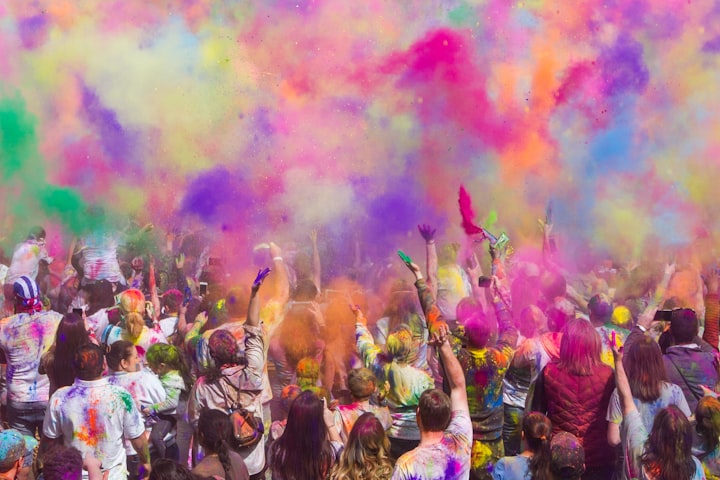
"Let's go buy our colors for tomorrow!"
That was the suggestion of German Heinrich, an amiable fellow I had been hanging out with for a week in Dharamshala in North India. His regular pal Paul was unavailable, having enrolled in a ten-day silent meditation course. I had met both guys on a twelve-hour overnight bus from Delhi to Dharamshala. As is typical when traveling solo, like-minded folks tend to gravitate toward each other.
I was unfamiliar with Holi, which would be celebrated with enthusiasm and fanfare the next day. But Heinrich had been coming to India for more than twenty years. And he spoke Hindi, so he was a terrific companion for partaking in local customs.
Always game for participating with aplomb in local cultural traditions, I replied, "Sure, what do we do?"
We were staying in Upper Dharamsala, McLeod Ganj, the area frequented by foreigners and also home of His Holiness the Dalai Lama. The city's permanent population is heavily Tibetan and Buddhist, so the Hindu Holi holiday, wouldn't be significant for them.
Our purchase
Hence, we trekked thirty minutes downhill to purchase our "colors" in Dharamsala, where the locals resided. They consisted of little plastic packets of vibrant, colored powders - yellow, hot pink, green, blue, red, silver, and gold. We stocked up but passed on the water guns, sprayers, and other accouterments used to add wildly spraying aqua to the party.
We were ready! The next decision was attire. Since whatever we wore would be trashed, I selected what I was willing to sacrifice: inexpensive pants, a kurta-style shirt, a sweater, a cloth bag, and my grungiest shoes.
Excitement of living abroad
I lean toward an enthusiastic childish approach, loving everything new and unusual when living abroad. Those who relish travel and adore life elsewhere thrive in cultures drastically divergent from our native countries. We are "outliers" in many respects. I admit to being one.
However, the more dissimilar the location, the greater the likelihood of challenges and hurdles, too.
Despite the ups and downs, if we change how we look at things, we humans can adapt to nearly anything. Our mindset adapts, our perspective is modified, and our expectations change. For example, when power outages were virtually a guarantee - daily - in various cities where I lived in India, instead of being upset or frustrated, I became thrilled when they lasted only an hour or two instead of eight!
As a half-glass-full kinda gal, I will take the hiccups and difficulties in places with less modernity any day, every day, over the same-old, same-old predictability of a boring, mundane existence where nothing untoward or disruptive ever occurs.
Festivals and celebrations
Enjoying unique traditions and festivals is part and parcel of exploring other countries' cultures. I rarely hang out with other foreigners. Instead, I choose to live in neighborhoods where locals reside and immerse myself as much as possible in their day-to-day existence.
After spending three years off and on in India, I was fortunate to participate in or witness many intriguing and delightful festivals and celebrations throughout the country. I adore the Indian people - their loving welcome and enthusiasm are why I return again and again - and Indians celebrate their holidays with vibrant, contagious glee.
Holi
A classic exuberant celebration is Holi, most recently celebrated on March 25. The holiday also signifies the arrival of spring. I participated in three of them. But my first in 2013 was engaged with gusto. Celebrated on a full moon day in the Hindu calendar month of Phalguna, the tradition varies in different areas of India. Some places either don't participate in Holi or it is of less importance.
Like many traditional festivals and celebrations, various explanations of its meaning often exist.
Hiranyakashipu conquered by Vishnu
In many places, Holi is associated with the not-so-uplifting tale of the sororocide by Hiranyakashipu, a demon king of ancient India, who enlisted the aid of his sister, Holika, to kill his son, Prahlada, a devotee of Vishnu. While attempting to burn her brother, Holika sat on the pyre, purportedly protected from the fire by a cloak.
But like all fables, things don't always end as they're meant. The coat saved Prahlada instead, and Holika burned. Later that night, the mighty Vishnu (one of the three major gods of the Hindu triumvirate) successfully killed Hiranyakashipu. The triumph of good over evil is a primary explanation for the Holi celebration.
A bonfire, Holika Dahan, lit the night before, is part of the tradition in many places.
Krishna and Radha iteration
In other places, the story of Krishna and Radha is central. Lord Krishna is most popular in North India, where, according to legend, he was born and lived.
If you're not up on your Hindu iconology, Krishna is one of the easiest gods to identify. His skin is blue, he often plays a flute, and he usually stands with one foot crossed over the other.
The story about Krishna, considered a manifestation of Vishnu, is that he fell in love with the ravishing milkmaid Radha but was embarrassed that his skin was dark blue and hers fair. To compensate, he playfully colored her face during a game with her and the other milkmaids. This is thought to be the origin of the colored water and powder throwing. The general merrymaking is also a characteristic of Krishna, known for his pranks and play.
Another explanation for using colors is that Krishna fell in love with the goddess Radha but feared she would not love him because of his blue skin. However, Radha allowed Krishna to dye her skin with color, making them a true couple. On Holi, participants apply color to each other's skin in honor of Krishna and Radha.
Regardless of which version you prefer, Holi is celebrated with wild enthusiasm in many parts of the country, especially by children and merrymakers. Apparently, as the day wears on, more alcohol is consumed, and antics become progressively wilder. In some locales, women abhor Holi because men drink too much and misbehave toward them. We abandoned the area before any craziness commenced.
Our Holi day
After Heinrich and I met for our usual breakfast and noticed no Holi festivities in the area, as we suspected might be the case, I proposed that we mosey down the hill to Dharamshally. A typical Indian town, that is indeed where the action was.
At a corner of intersecting roads, a large black cow lay peacefully in a massive heap of garbage. Already a "holy" creature, of course, she had been anointed with multiple bags of color poured on her. As we added to the array, she lazily swished her tail from, otherwise unperturbed.
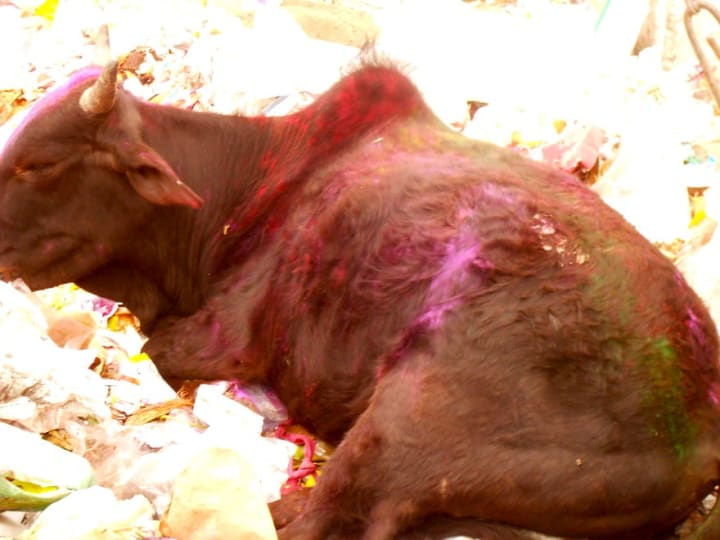
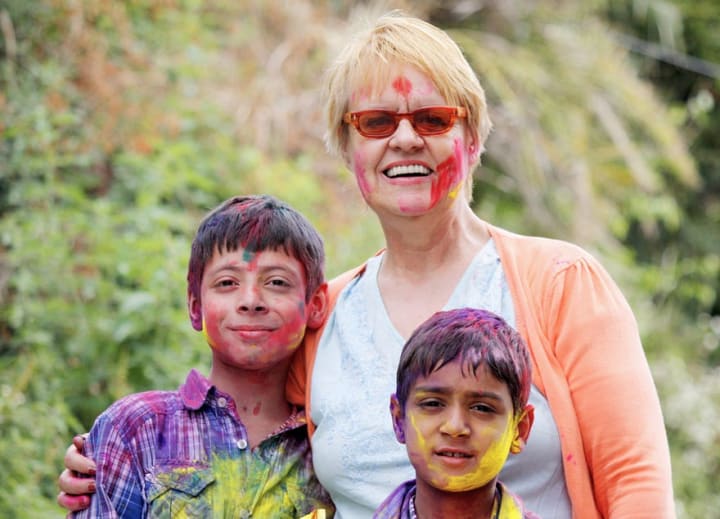
Other foreigners were gleefully participating, too. One group was wearing all-white. Another group of young women chose matching gray-colored attire. Everyone was having the time of their lives!

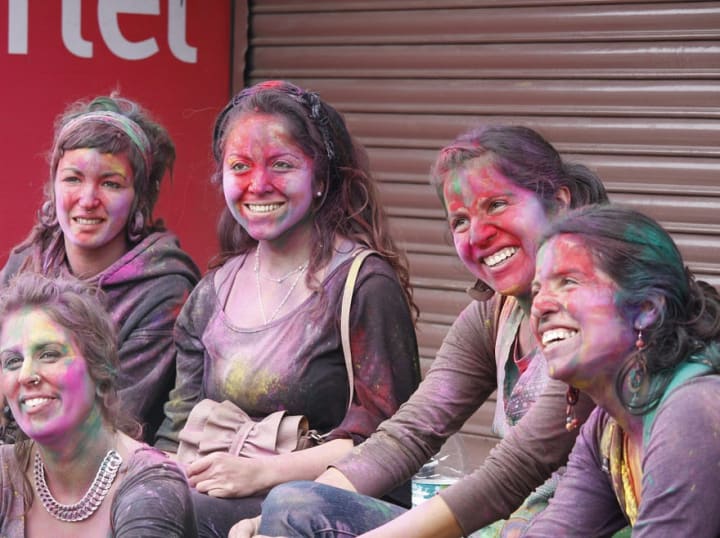
The rambunctious Holi activities involve a free-for-all delivery of "colors" that symbolize love. Brightly colored powders may be tossed onto participants, more gently dabbed on heads or cheeks, smeared here and there on body parts, or wildly poured over people.
Adding to the merriment…and mess…water is often sprayed from guns or hoses, and water balloons are thrown at passersby. Happily, not much aqua was used here because it would have been chilly wandering around for hours soaking wet.
Wandering around, Heinrich and I were slathered head-to-toe in brilliant colors. We were quite the celebrities, receiving many comments about how delightful we looked. We posed for countless obligatory photographs with locals. I was worried that with all the powders, no one would allow us into their taxis. But it wasn't a problem; this is, after all, India!
As the day wore on, we were bombarded with colors. Kids especially loved to toss huge handfuls on us. They were always thrilled to pose for photographs.


Everyone I sent my images to loved them. Nephew Brent's reply, with his offbeat sense of humor, was the best, "Sure, blame it on the festival when really you were drunk and had trouble putting on your makeup!"

I chose not to focus on any toxic or deleterious effects of what the powders might be comprised of. "When in Rome and all that!" Happily, I had no adverse skin reactions. My clothing was completely trashed, aside from my shoes, which I managed to hose off, clean, and continue to wear.
Celebrations elsewhere
Although primarily celebrated in India, Hindus around the world celebrate. These wonderful shots are from celebrations across the globe, including Los Angeles, Kenya, Pakistan, and Nepal.
https://www.theatlantic.com/photo/2024/03/photos-holi-2024-festival-colors/677876/
Resources
1. https://www.britannica.com/story/holi-festival-of-colors
2. https://www.thehindu.com/news/national/holi-2024-in-pictures-colourful-celebrations-underway-across-the-nation/article67990122.ece
3. https://www.ndtv.com/offbeat/holi-2024-know-why-the-festival-of-colours-is-celebrated-5306853
4. https://www.theatlantic.com/photo/2024/03/photos-holi-2024-festival-colors/677876/
Your time is valuable. Thanks for spending some of it here.
Victoria
About the Creator
Victoria Kjos
I love thinking. I respect thinking. I respect thinkers. Writing, for me, is thinking on paper. I shall think here. My meanderings as a vagabond, seeker, and lifelong student. I'm deeply honored if you choose to read any of those thoughts.


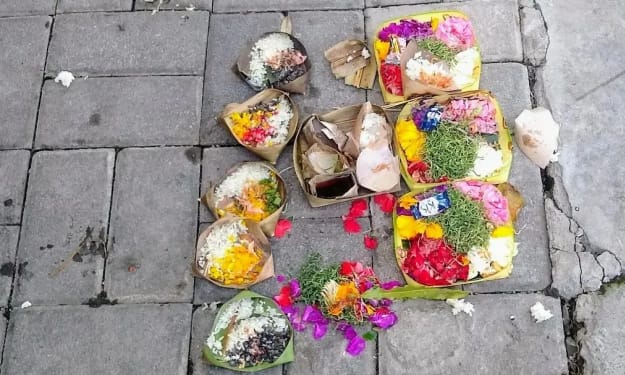

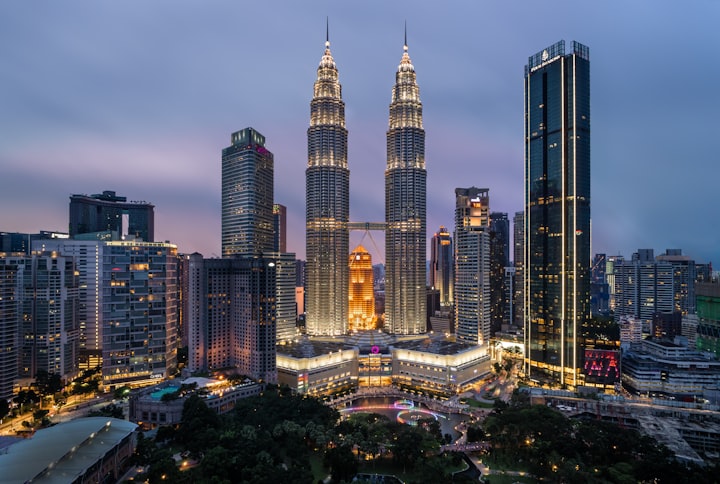

Comments
Victoria Kjos is not accepting comments at the moment
Want to show your support? Send them a one-off tip.